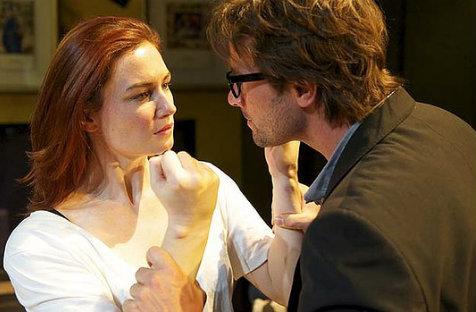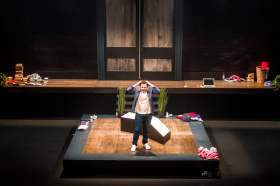Pierre paces Katya’s apartment, his phone clutched to his ear. She’s in the other room, taking a shower while he waits. Given they’ve only just met, this seems a somewhat provocative move on her part. Indeed, it’s as if she (her absent, naked, imagined self) is right there in the room with him – or it would be if Pierre, raging at his editor, wasn’t, himself, somewhere else.
Pierre is a journalist, Katya an actor. These roles, too, are self-contradictory and opposed: journalists deal in facts, actors in fantasy. Or is it really that actors quest for truth, while journalists just want a good story? Judging by her wall-hangings, Katya is an admirer of Marilyn Monroe, who’s celebrated more for her sublime manipulation of her own public image than for any of the roles she played on film. Certainly it seems that Katya is always ‘on’, much like her constantly ringing phone. Its ringtone, appropriately, is a voice ‘impersonating’ a ringtone.
Pierre, on the other hand, is a political reporter, and feels that ‘fluff pieces’ about celebrities are beneath him. Yet here he is, in her apartment. And in going to some lengths to convince Katya that he both knows nothing and wants to know nothing about her, he actually betrays more than a passing familiarity with his subject. Still, by the time he finally turns on his voice recorder, he has offended her enough that the first words out of her mouth are that their interview is over. Of course, it isn’t. It’s just the beginning.
As you may have guessed by now, Theo Van Gogh’s The Interview is inherently paradoxical, and the play as a whole could be said to represent the liar’s paradox in particular. But which liar are we to believe? It makes for a fascinating intellectual experience, if not a wholly satisfying one emotionally. Early in the play, for example, Katya demonstrates her skill at crying on cue; later, when Pierre confesses a dark secret to her, the viewer is left unsure whether we believe either his story or her heartfelt reaction to it. Therein lies The Interview’s appeal, but not knowing what to believe also means we don’t know with whom to sympathise, and can’t necessarily sympathise at all when the play requires it of us. Similarly, despite turning in thoughtful performances as Katya and Pierre, Alison McGirr and Kip Gamblin often seem at arms’ length from each other, disconnected. As if they’re always on their phones, talking to someone else.
Indeed, perhaps the strongest point of emotional engagement between the characters (and with the audience) occurs when Katya and Pierre film each other, and thus seem to be talking directly to us through the television in Katya’s living room. The irony of this ties very much into the central idea of the play, and is a lovely piece of staging by director Sam Atwell, whose direction is typically energetic and imaginative. Likewise, Tom Bannerman’s gorgeous set design is at once naturalistic and surreal – perfect for this material. Having worked with both Atwell and Bannerman on two successful runs of Bondi Dreaming, Alon Ilsar’s sound and music was stymied on the night by technical difficulties, though this was evident during the performance only in that it seemed underused.
A difficult but intriguing piece of work, The Interview is worth a look, and its relatively short running time is offset by the likelihood that it will stay with you, playing on your mind, for some time after you’ve left the theatre.
Rating: 3 stars out of 5
The Interview
By Theo Van Gogh
Adapted and directed by Sam Atwell
Set design by Tom Bannerman
Lighting design by Nicholas Rayment
Composition and sound design by Alon Ilsar
Produced by Nick Bolton
Performed by Alison McGirr and Kip Gamblin
The Bondi Pavilion Theatre, Bondi Beach
31 October – 23 November





